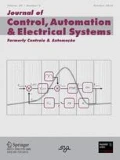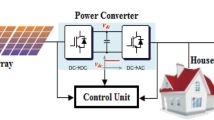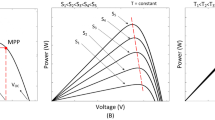Abstract
In the context of recent advancements in 3-phase phase-locked loop (PLL) structures to tackle grid imperfections, this paper attempts to shift focus towards dynamic response optimization for fast tracking of disturbed grids, as opposed to Wiener optimization, a trade-off between filtering characteristic and dynamic response. In this respect, an ingenious self-consistent model (SCM)-based approach is proposed which explores filter design in the presence of frequency shifts and phase jumps, and facilitates the analytical computation of unique loop filter parameters. Trial and error in filter parameter selection is inconvenient, but more importantly, even rigorous trials would be insufficient in qualifying the non-existence of a better design. Having eliminated trial and error, this novel technique limits transients to user specifications while fixing on an optimum damping ratio, to yield the best fit. The design methodology is applied to three existing 3-phase PLL structures modelled in MATLAB/Simulink, and the proposed method is further evaluated through extensive simulations and performance comparisons with the traditional Wiener approach. To enhance the understanding of model behaviour and the feasibility of practical implementation, comprehensive three-dimensional (3-D) lookup tables are presented. They enable the study of optimized filter parameter variations for a range of grid disturbances, and broaden the application to filter optimization in real-time. In the interest of the reader, this paper is structurally split into two parts. Part 1 covers the premise and theory that explicates the proposed SCM methodology. The detailed analysis and verification of the SCM are covered in Part 2.











Similar content being viewed by others
Notes
This window is particularly chosen due to the known sluggishness in the response with \(\delta > 1\), as can be shown analytically, but is beyond the scope of this paper.
References
Blackburn, J. L. (1993). Symmetrical components for power systems engineering (1st ed.). Boca Raton: CRC Press.
Bollen, M. H. J. (1996). Fast assessment methods for voltage sags in distribution systems. IEEE Transaction on Industry Application, 32(6), 1414–1423.
Chung, S. K. (2000). A phase tracking system for three phase utility interface inverters. IEEE Transactions on Power Electronics, 15(3), 431–438.
da Silva, C. H., Pereira, R. R., da Silva, L. E. B., Lambert-Torres, G., Bose, B. K., & Ahn, S. U. (2010). A digital PLL scheme for three-phase system using modified synchronous reference frame. IEEE Transactions on Industrial Electronics, 57(11), 3814–3821.
Gardner, F. M. (2005). Phaselock Techniques (3rd ed.). New Jersey: John Wiley & Sons Inc.
Golestan, S., Monfared, M., Freijedo, F. D., & Guerrero, J. M. (2012). Design and tuning of a modified power-based PLL for single-phase grid-connected power conditioning systems. IEEE Transactions on Power Electronics, 27(8), 3639–3650.
González-Espín, F., Figueres, E., & Garcerá, G. (2012). An adaptive synchronous-reference-frame phase-locked loop for power quality improvement in a polluted utility grid. IEEE Transactions on Industrial Electronics, 59(6), 2718–2731.
Gulez, K. (2008). Neural network based switching control of AC-AC converter with DC-AC inverter for voltage sags, harmonics and EMI reduction using hybrid filter topology. Simulation Modelling Practice and Theory, 16(6), 597–612.
Guo, X., Wu, W., & Chen, Z. (2011). Multiple-complex coefficient-filter-based phase-locked loop and synchronization technique for three-phase grid-interfaced converters in distributed utility networks. IEEE Transactions on Industrial Electronics, 58(4), 1194–1204.
Karimi-Ghartemani, M., & Iravani, M. R. (2004). A method for synchronization of power electronic converters in polluted and variable-frequency environments. IEEE Transactions on Power Systems, 19(3), 1263–1270.
Kaura, V., & Blasko, V. (1997). Operation of a phase locked loop system under distorted utility conditions. IEEE Transactions on Industry Applications, 33(1), 58–63.
Kesler, M., & Ozdemir, E. (2011). Synchronous-reference-frame-based control method for UPQC under unbalanced and distorted load conditions. IEEE Transactions on Industrial Electronics, 58(9), 3967–3975.
Krause, P. C., Wasynczuk, O., & Sudhoff, S. D. (2002). Analysis of electric machinery and drive systems. New Jersey: IEEE Press.
Kulkarni, A., & John, V. (2013). Analysis of bandwidth - unit vector distortion trade off in PLL during abnormal grid conditions. IEEE Transactions on Industrial Electronics, 60(12), 5820–5829.
Lee, K. J., Lee, J. P., Shin, D., Yoo, D. W., & Kim, H. J. (2014). A novel grid synchronization PLL method based on adaptive low-pass notch filter for grid-connected PCS. IEEE Transactions on Industrial Electronics, 61(1), 292–301.
Liccardo, F., Marino, P., & Raimondo, G. (2011). Robust and fast three-phase PLL tracking system. IEEE Transactions on Industrial Electronics, 58(1), 221–231.
Rodríguez, P., Pou, J., Bergas, J., Candela, I., Burgos, R., Boroyevich, D. (2005) Double synchronous reference frame PLL for power converters control. In: Proc. 36th IEEE PESC, pp 1415–1421.
Rodríguez, P., Teodorescu, R., Candela, I., Timbus, A., Liserre, M., Blaabjerg, F. (2006) New positive-sequence voltage detector for grid synchronization of power converters under faulty grid conditions. In: Proc. 37th IEEE PESC, pp 1–7.
Rodríguez, P., Pou, J., Bergas, J., Candela, J. I., Burgos, R. P., & Boroyevich, D. (2007). Decoupled double synchronous reference frame PLL for power converters control. IEEE Transactions on Power Electronics, 22(2), 584–592.
Wang, L., Jiang, Q., Hong, L., Zhang, C., & Wei, Y. (2013). A novel phase-locked loop based on frequency detector and initial phase angle detector. IEEE Transactions on Power Electronics, 28(10), 4538–4549.
Weidenbrug, R., Dawson, F. P., & Bonert, R. (1993). New synchronization method for thyristor power converters to weak AC-systems. IEEE Transactions on Industrial Electronics, 40(5), 505–511.
Author information
Authors and Affiliations
Corresponding author
Appendix
Appendix
1.1 A Analysis of Cardan’s Roots Through Analytic Means
1.1.1 A.1 Cardan’s Solution to the Cubic Equation in \(\delta \)
Consider the general form of a cubic equation
When \(a \ne 0\), Eq. (38) can be re-written as
where \(l=b/a\), \(m=c/a\) and \(n=d/a\). Substituting \(y=x+l/3\), Eq. (39) becomes
where \(p\) and \(q\) are the Cardan simplifiers given in Eqs. (28) and (29), respectively. Let \(y = u+v\). i.e.
On comparing the coefficients of Eqs. (40) and (41), we get
Solving Eqs. (42) and (43) yields
The roots of Eq. (44) are given by
where \(\lambda \) is as shown in Eq. (31) and
On back substitution of the values of \(u\) from Eq. (45), we consequently obtain the values of \(x\), which satisfy Eq. (39) as
Thus, the roots of the cubic equation in Eq. (39) are found by Cardan’s technique.
1.1.2 A.2 Nature of the Roots
Of the three roots found using Cardan’s method, either one root may be real and the other two imaginary, or all three roots may be real. To arrive at the condition for three real roots, a calculus-based approach is followed. Let
As can be inferred from inspection, the cubic function is unbound. i.e. \(f(y)\in (-\infty ,+\infty )\). Also, for three roots to be real, \(f(y)\) curve should intersect the \(f(y)=0\) axis thrice (or at least twice, in case two of the real roots are equal). The stationary points of \(f(y)\) are given by
and the local extrema viz., \(f(-y_0) = f_\mathrm{max}\) and \(f(+y_0) = f_\mathrm{min}\) are as shown in Fig. 12.
For the existence of three real roots, the stationary points of \(f(y)\) should be real and the product \(f_\mathrm{max}.f_\mathrm{min}\) should be either negative or zero. i.e.
On simplification, Eq. (52) becomes
Conditions in Eqs. (51) and (53) are thus necessary for the existence of three real roots. However, Eq. (51) is already included in Eq. (53). Therefore, Eq. (53) becomes the necessary and sufficient condition for the three roots to be real.
1.1.3 A.3 Choice of Optimum \(\delta \) in \([0,1]\)
Having arrived at the solutions to the cubic equation, it is crucial to qualify the presence of a real root in the region of interest; i.e. the optimum \(\delta \) in \([0,1]\). Following are the possibilities that would require further analysis in selecting the optimum \(\delta \):
-
All of the three real roots from Eq. (32) may lie in \([0,1]\)
-
Two of the three real roots from Eq. (32) may lie in \([0,1]\)
-
None of the three real roots from Eq. (32) may lie in \([0,1]\)
-
The only real root from Eq. (30) may not lie in \([0,1]\)
A systematic approach is followed to conclude on the valid cases analytically.
1.1.4 Case 1: Three Real Roots Lie in \([0,1]\)
This possibility can be overruled through contradiction. Let the three real roots viz., \(\delta _1\), \(\delta _2\) and \(\delta _3\) lie in \([0,1]\). Then the sum and product of roots are given by
Since \(\delta _1\), \(\delta _2\) and \(\delta _3\) \(\in [0,1]\),
This implies
But from Eq. (24), we have
which is always positive. Clearly, Eqs. (57) and (59) are an inconsistency, and the initial assumption is incorrect. Thus, it is impossible for the three real roots of Eq. (32) to lie in \([0,1]\).
1.1.5 Case 2: Two Real Roots Lie in \([0,1]\)
Two aspects viz., slope of the phase error band at \(\delta =0\) and the limiting value of phase error band as \(\delta \rightarrow 1\), are used to conclude that two real roots from Eq. (32) cannot lie in \([0,1]\).
-
1.
The slope of the error expression in Eq. (21) at \(\delta =0\) is given by
$$\begin{aligned} E^\prime (\delta )\Big |_{\delta =0} = E^\prime (0) = \dfrac{2}{\omega _n\sqrt{c_1}}\Big \{-(c_2+\omega _n t_0 c_1)\Big \} \end{aligned}$$(60) -
2.
The limiting value of the phase error band as \(\delta \rightarrow 1\) is given by
$$\begin{aligned} E(\delta )\Big |_{\delta \rightarrow 1} = \lim _{\delta \rightarrow 1}\dfrac{2e^{-\delta \omega _n t_0}}{\omega _n\sqrt{1-\delta ^2}}\sqrt{c_1-2c_2\delta } \end{aligned}$$(61)
If \(c_2+\omega _n t_0 c_1 > 0\), then from Eq. (60), \(E^\prime (0) < 0\). Physically, this means that the rate of change of \(E(\delta )\) is negative as \(\delta \) increases from zero. From Eq. (61), \(E\rightarrow \infty \) as \(\delta \rightarrow 1\), provided \(c_1-2c_2 \ne 0\).
Since the error band initially decreases from \(\delta =0\) and eventually approaches infinity as \(\delta \rightarrow 1\), there can be either one or three stationary points in \([0,1]\) which satisfy this nature. However, since the possibility of three real roots in \([0,1]\) is eliminated previously, the only possibility is the existence of one real root in \([0,1]\), which can either be from Eq. (30) or Eq. (32). For one such specific case, the variation of error band is shown in Fig. 13.
1.1.6 Case 3: No Real Root Lies in \([0,1]\)
There can be two corner cases when none of Cardan’s real roots from Eqs. (30) or (32) lie in \([0,1]\).
-
1.
First corner case: When \(c_2+\omega _n t_0 c_1 > 0\) and \(c_1-2c_2 = 0\), the error band has an initial negative slope (\(E^\prime (0) < 0\)) and the limiting value of \(E\) is finite as \(\delta \rightarrow 1\). In other words, the error band initially decreases from \(\delta =0\), and has a finite value at \(\delta =1\). This leaves us with the possibility of either zero or two stationary points in \([0,1]\). Substituting \(c_1=2c_2\) in Eq. (21), the error band becomes
$$\begin{aligned} E = \dfrac{2e^{-\delta \omega _n t_0}}{\omega _n\sqrt{1+\delta }} \sqrt{2c_2} \end{aligned}$$(62)which is a continually decreasing function with \(\delta \). This eliminates the possibility of two stationary points in \([0,1]\). Hence, for this case, there is no stationary point in \([0,1]\), and the minimum error band occurs at \(\delta =1\), as shown in Fig. 14. The optimum \(\delta \) for this corner case is chosen as \(\delta =1\).
-
2.
Second corner case: When \(c_2+\omega _n t_0 c_1 < 0\), the error band has an initial positive slope (\(E^\prime (0) > 0\)). Also, since \(c_1\) is always positive from Eq. (22), \(c_2+\omega _n t_0 c_1 < 0\) implies that \(c_2\) is negative; i.e. \(c_1-2c_2 \ne 0\). Thus, \(E\rightarrow \infty \) as \(\delta \rightarrow 1\), from Eq. (61). Since the error band initially increases from \(\delta =0\), and approaches infinity as \(\delta \rightarrow 1\), there can be either zero or two stationary points in \([0,1]\). To eliminate the possibility of two stationary points of \(E(\delta )\) in \([0,1]\), consider \(E^\prime (\delta )\) given by
$$\begin{aligned} E^\prime (\delta ) = \dfrac{2e^{-\delta \omega _n t_0}}{\omega _n\left( 1-\delta ^2\right) ^{\frac{3}{2}}\sqrt{c_1-2c_2\delta }}~f(\delta ) \end{aligned}$$(63)where
$$\begin{aligned} f(\delta )&= (-2\omega _n t_0 c_2)\delta ^3 + (-c_2 + \omega _n t_0 c_1)\delta ^2 \nonumber \\&+\, (c_1 + 2\omega _n t_0 c_2)\delta + (-c_2-\omega _n t_0 c_1) \end{aligned}$$(64)From Eq. (64), the following are implied, specifically for this corner case:
-
\(f(0)>0\)
-
\(f(1)>0\)
-
\(f^\prime (0)>0\)
-
\(f^\prime (1)>0\)
-
Neither of the two stationary points of \(f(\delta )\) lie in \([0,1]\) Thus, \(f(\delta )\) is always increasing in \([0,1]\). Since \(f(\delta )\) has no roots in \([0,1]\), there cannot be two stationary points of \(E(\delta )\) in \([0,1]\). The only other possibility is that \(E(\delta )\) has no stationary points and is always increasing with \(\delta \) in \([0,1]\), as shown in Fig. 15. Since the minimum error band occurs at \(\delta =0\), the optimum \(\delta \) for this case is chosen as \(\delta =0\).
-
The various possibilities are explored and the invalid cases are eliminated. The consolidated inferences in choosing the optimum \(\delta \) on solving the cubic Eq. (24) by Cardan’s method are listed in Table 2.
Rights and permissions
About this article
Cite this article
Jain, S.R., Ravikirthi, P. & Chilakapati, N. A Novel Self-Consistent Model Based Optimal Filter Design for the Improved Dynamic Performance of 3-phase PLLs for Phase Tracking Under Grid Imperfections. J Control Autom Electr Syst 25, 608–619 (2014). https://doi.org/10.1007/s40313-014-0137-3
Received:
Revised:
Accepted:
Published:
Issue Date:
DOI: https://doi.org/10.1007/s40313-014-0137-3








